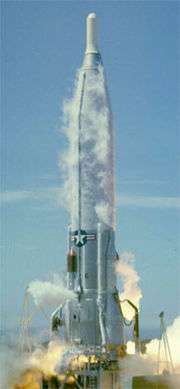Atlas I
 Launch of the maiden flight of the Atlas I, with the CRRES satellite | |
| Function | Expendable launch system |
|---|---|
| Manufacturer | Convair |
| Country of origin | United States |
| Size | |
| Height | 43.90m (144.00 ft) |
| Diameter | 3.05m (10 ft) |
| Mass | 164,300kg (362,200 lb) |
| Stages | 2.5 |
| Associated rockets | |
| Family | Atlas |
| Launch history | |
| Status | Retired |
| Launch sites | LC-36B, Cape Canaveral |
| Total launches | 11 |
| Successes | 8 |
| Failures | 3 |
| First flight | 25 July 1990 |
| Last flight | 25 April 1997 |
The Atlas I was an American expendable launch system, used in the 1990s to launch a variety of different satellites. The "I" in "Atlas I" can cause confusion, as all previous Atlas rockets were designated using letters, ending with the Atlas H, however subsequent rockets were designated using Roman numerals, starting with the Atlas II. Officially, the "I" is the Roman numeral "1". Eleven launches took place, with three failures.
The first stage of the Atlas I was derived from Atlas G, and the second stage was a Centaur. The first stage had an improved MA-5A propulsion system, consisting of the LR-89 booster engine with dual thrust chambers and a more powerful RS-27 replacing the traditional LR-105 sustainer engine. With the new RS-27 sustainer engine, all three of the large Atlas thrust chambers produced equal thrust.[1] Booster engine jettison occurred prior to sustainer engine cut-off for stage-and-a-half staging of the Atlas. (Used in conjunction with the Centaur, this gave the Atlas I 2.5 stages).
Atlas I was the last use of the classic Atlas design with three engines, jettisonable booster section, and two vernier engines, as Atlas II, while retaining most of those features, replaced the verniers with a hydrazine roll control system.
Launch history
| Date/Time (GMT) | Serial Number | Payload | Outcome | Remarks | |
|---|---|---|---|---|---|
| Atlas | Centaur | ||||
| 25 July 1990, 19:21 | AC-69 | 5049 | CRRES | Successful | Maiden flight of Atlas I, spacecraft later failed |
| 18 April 1991, 23:30 | AC-70 | 5050 | Yuri 3H | Failure | One Centaur engine failed to start due to debris lodged in the LH2 turbopump. RSO destruct at T+441 seconds. |
| 14 March 1992, 00:00 | AC-72 | 5052 | Galaxy 5 | Successful | |
| 22 August 1992, 22:40 | AC-71 | 5051 | Galaxy 1R | Failure | Centaur engine failure followed by RSO destruct. Unlike the 1991 launch, this incident was caused by LH2 mixing with atmospheric nitrogen to form a plug in a valve caused by an experimental procedure to increase performance by cooling the Centaur engines prior to ignition. |
| 25 March 1993, 21:38 | AC-74 | 5054 | UHF F-1 | Failure | An improperly torqued set screw caused the Atlas sustainer engine to drop to 75% thrust starting at T+25 seconds. By booster staging at T+120 seconds, sustainer thrust was down to 60%. The payload was placed in an unusable orbit. This was the last failed launch involving an Atlas vehicle. |
| 3 September 1993, 11:17 | AC-75 | 5055 | UHF F-2 (USA-95) | Successful | |
| 13 April 1994, 06:04 | AC-73 | 5053 | GOES-8 (GOES-I) | Successful | |
| 24 June 1994, 13:50 | AC-76 | 5056 | UHF F-3 (USA-104) | Successful | |
| 23 May 1995, 05:52 | AC-77 | 5057 | GOES-9 (GOES-J) | Successful | |
| 30 April 1996, 04:31 | AC-78 | 5058 | BeppoSAX | Successful | |
| 25 April 1997, 05:49 | AC-79 | 5059 | GOES-10 (GOES-K) | Successful | Final flight of Atlas I[2] |
See also
References
- ↑ Dennis R. Jenkins, "Stage-and-a-Half, The Atlas Launch Vehicle", To Reach the High Frontier (University Press of Kentucky, 2002) p. 92
- ↑ "Atlas I Successfully Launches GOES-K". International Launch Services. April 25, 1997. Retrieved 2013-03-16.
